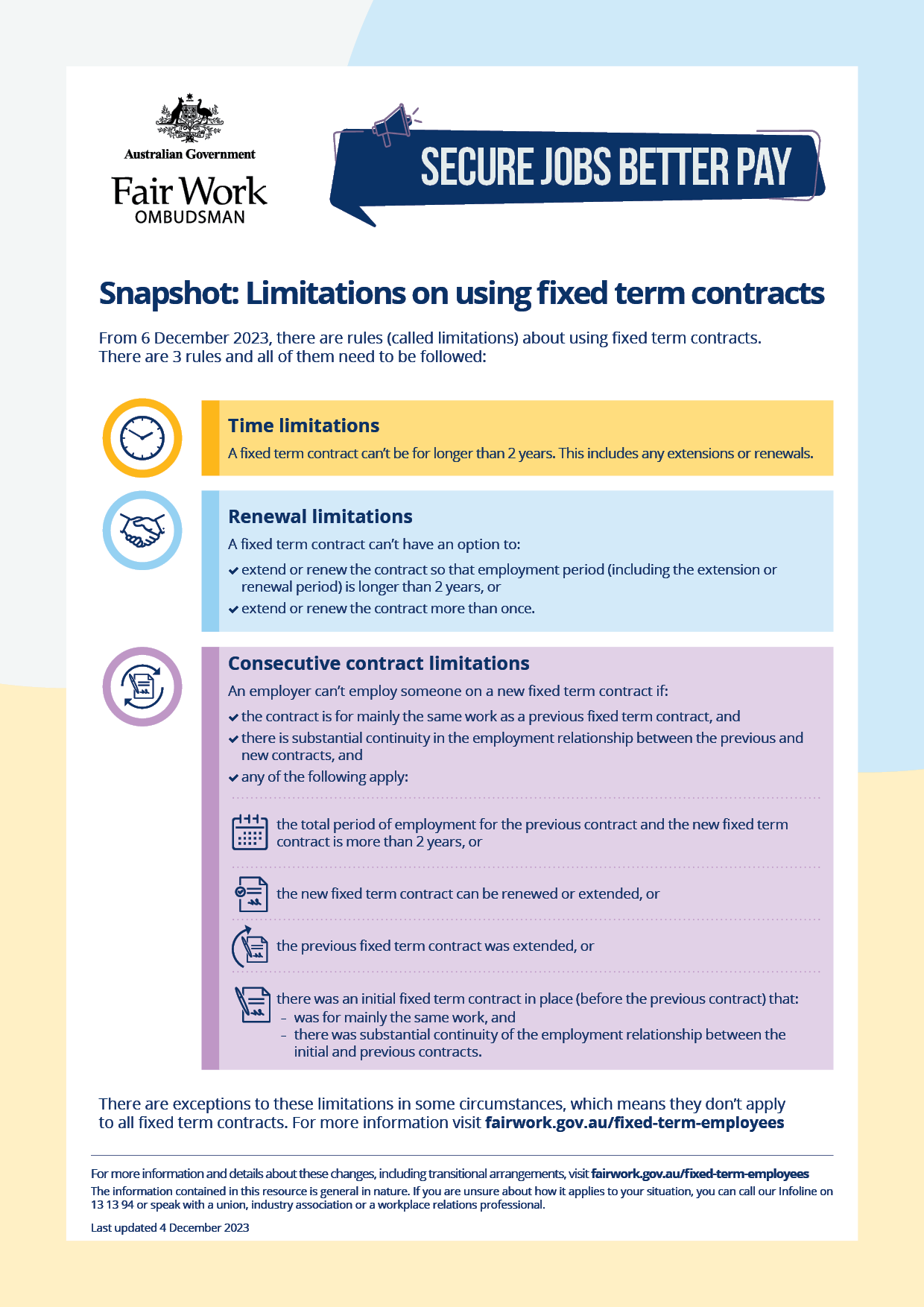
From 6 December 2023, new rules apply when engaging employees on fixed term contracts.
These changes include:
– Time Limitations
– Renewal Limitations
– Consecutive Contract Limitations
A fixed term contract terminates at the end of a set period (for example, the contract ends on a set date or after a set period of time or a season).
The new rules include a requirement for employers to give any employees they’re engaging on a new fixed term contract a Fixed Term Contract Information Statement (FTCIS).
They also include some limitations on how fixed term contracts can be used. There are some exceptions to who these limitations apply to which means they don’t apply to all fixed term contracts. The limitations also don’t apply to casual employees.
Fixed Term Contract Information Statement
From 6 December 2023, employers must give every employee engaged under a new fixed term contract a copy of the Fixed Term Contract Information Statement (FTCIS). The FTCIS needs to be given when the employee enters, or as soon as possible after entering, the fixed term contract.
The FTCIS provides fixed term employees with information about fixed term employment, including the rules about when fixed term contracts are allowed to be made.
REMINDER: Fair Work Information Statement In addition to the FTCIS, employers need to provide all new employees with the Fair Work Information Statement. This is a separate document that provides information about minimum workplace rights and entitlements. For more information, go to Fair Work Information Statement.
Ben is a new part-time employee at a marketing agency.
Ben is employed on a 12-month full-time contract to cover a parental leave position. He signs his fixed term contract on 18 December 2023.
Because Ben is a new employee and employed on a fixed term contract, his employer, Gina, must provide him with 2 important documents. These are the:
– Fair Work Information Statement (FWIS)
– Fixed Term Contract Information Statement (FTCIS).
Gina must give Ben the FWIS because he’s a new employee.
Gina must give Ben the FTCIS because he is entering a fixed term contract after 6 December 2023.
Limitations on Fixed Term Contracts
There are rules about when fixed term contracts can be used. These are also called limitations.
These limitations apply for fixed term contracts made on or after 6 December 2023, if no exceptions apply.
Time Limitations
A fixed term contract can’t be for longer than 2 years. This includes any extensions or renewals.
John is offered a fixed term contract with a cleaning company for 3 years.
This contract breaches the limitations because it’s for more than 2 years.
Renewal Limitations
A fixed term contract can’t have an option to:
- extend or renew the contract so the period of employment lasts for longer than 2 years, or
- extend or renew the contract more than once
Chelsea is given a contract for 6 months which has a right for her employer to extend twice for up to 4 months each time.
This contract breaches limitations because a fixed term contract can’t have an option or right to extend more than once, even if the total period is less than 2 years.
Consecutive Contract Limitations
An employee can’t be offered a new fixed term contract if the first 3 points below all apply, and one or more of the scenarios in the 4th point applies.
- Their previous contract was also for a fixed term.
- Their previous contract and the new contract are for mainly the same work.
- There is substantial continuity in the employment relationship between the previous and new contracts, and
- Either:
- the previous contract contained an option to extend that was used
- the total period of employment for both the previous and new fixed term contract is more than 2 years
- the new fixed term contract contains an option to renew or extend, or
- there was an initial contract in place (before the previous contract):
- that was for a fixed term,
- that was for the same or similar work, and
- where there was substantial continuity in the employment relationship.
Ahmad was employed on a fixed term contract as a site engineer for a construction company.
His initial contract was for the period of 1 January 2022 to 31 December 2022. It included an option for a one year extension, which his employer used, making the new end date 31 December 2023.
On 1 January 2024, Ahmad signed a new fixed term contract for a term of 1 more year for the same position.
This contract breaches the limitations because:
- the previous contract had a right to extend in it
- the total employment period under both contracts is more than 2 years, and
- the contracts are for the same position and there is continuity in the employment relationship between both contracts.
Protections for Employees
Employers can’t take certain actions to purposely avoid these rules.
These are called the anti-avoidance protections. These protections include:
- ending employment or not re-employing the employee for a period of time
- not re-engaging the employee and employing someone else to do the same or substantially similar work instead, or
- changing the type of work or tasks that an employee does or changing the employment relationship.
If an employer does any of these things, it may also be adverse action.
Find out more about adverse action at Protections at work.
Fixed term contracts before 6 December 2023
The limitations don’t apply to fixed term contracts entered into before 6 December 2023. However, fixed term contracts entered into before 6 December must be considered when applying the consecutive contracts limitation for a new fixed term contract that is entered into on or after 6 December 2023.
For full exceptions and limitations click the button below:
Snapshot Summary:

Have questions?
Contact us below!
